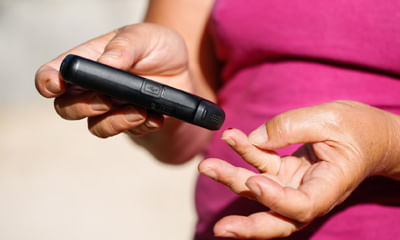Get the App
For Doctors
Login/Sign-up
Last Updated: Aug 29, 2019
BookMark
Report
how to reduce diabetic eye pressure
Diabetes causes vascular damage throughout the body. Because the blood vessels within the eye are so tiny, any damage at all can have a tremendous impact on eye health.
One of the most prevalent of the diabetes-related eye diseases is glaucoma. In fact, people with diabetes are between 40% and 50% more likely to develop glaucoma than non-diabetics.
Glaucoma causes the pressure within the eye to increase gradually, damaging the optic nerve and leading to partial or complete vision loss. The exact mechanisms for this are unknown. While there are several types of glaucoma, the most common form is open-angle glaucoma.
Open-angle glaucoma
The eye is full of fluid which continually refreshes. Normally, fluid drains at a point in the eye where the iris and the cornea meet. If this opening becomes even partially blocked the fluid drains out of the eye too slowly, even as new fluid is added. This backup of fluid causes an increase in pressure within the eye, damaging the optic nerve.
Open-angle glaucoma does not cause any symptoms until the disease is well-advanced. By that time, vision is impacted, with loss of peripheral vision first, advancing to tunnel vision and then total vision loss as the disease progresses.
Treatment
The goal of treatment is to lower intraocular pressure. This can be approached one of three ways: lower eye pressure, improve drainage of fluid from the eye or decrease the volume of fluid produced within the eye.
There are a variety of eye drops that may be prescribed.
Prostaglandins (xalatan, lumigan) and cholingeric agents (isopto carbine and isopto carbachol) act to increase outflow of fluid from within the eye.
Beta blockers (betimol, timoptic, betoptic) and carbonic anhydrase inhibitors (trusopt, azopt) reduce the production of fluid within the eye.
Alpha-adrenergic agonists (iopidine, alphagan) both lessen fluid production and increase fluid outflow.
Physicians may prescribe a combination of the above.
Oral medications may also be prescribed, if eye drops alone are not sufficient. These are usually in the form of a carbonic anhydrase inhibitor.
If medications are not sufficient to halt progression of the disease, then surgery might be necessary.
Drainage implants might be inserted within the eyes to facilitate drainage.
Laser surgery, known as laser trabeculoplasty, can be done to open clogged drainage canals.
Filtering surgery, known as trabeculectomy, removes a small piece of tissue from the location of the drainage canals, widening the opening and improving drainage.
The best possible treatment for glaucoma is prevention. Everyone above 40 years of age should have an eye exam at least every three years. Diabetics should have a dilated examination of their eyes annually.
Well-controlled blood sugar level are another preventive measure that will lessen the odds of developing glaucoma.
One of the most prevalent of the diabetes-related eye diseases is glaucoma. In fact, people with diabetes are between 40% and 50% more likely to develop glaucoma than non-diabetics.
Glaucoma causes the pressure within the eye to increase gradually, damaging the optic nerve and leading to partial or complete vision loss. The exact mechanisms for this are unknown. While there are several types of glaucoma, the most common form is open-angle glaucoma.
Open-angle glaucoma
The eye is full of fluid which continually refreshes. Normally, fluid drains at a point in the eye where the iris and the cornea meet. If this opening becomes even partially blocked the fluid drains out of the eye too slowly, even as new fluid is added. This backup of fluid causes an increase in pressure within the eye, damaging the optic nerve.
Open-angle glaucoma does not cause any symptoms until the disease is well-advanced. By that time, vision is impacted, with loss of peripheral vision first, advancing to tunnel vision and then total vision loss as the disease progresses.
Treatment
The goal of treatment is to lower intraocular pressure. This can be approached one of three ways: lower eye pressure, improve drainage of fluid from the eye or decrease the volume of fluid produced within the eye.
There are a variety of eye drops that may be prescribed.
Prostaglandins (xalatan, lumigan) and cholingeric agents (isopto carbine and isopto carbachol) act to increase outflow of fluid from within the eye.
Beta blockers (betimol, timoptic, betoptic) and carbonic anhydrase inhibitors (trusopt, azopt) reduce the production of fluid within the eye.
Alpha-adrenergic agonists (iopidine, alphagan) both lessen fluid production and increase fluid outflow.
Physicians may prescribe a combination of the above.
Oral medications may also be prescribed, if eye drops alone are not sufficient. These are usually in the form of a carbonic anhydrase inhibitor.
If medications are not sufficient to halt progression of the disease, then surgery might be necessary.
Drainage implants might be inserted within the eyes to facilitate drainage.
Laser surgery, known as laser trabeculoplasty, can be done to open clogged drainage canals.
Filtering surgery, known as trabeculectomy, removes a small piece of tissue from the location of the drainage canals, widening the opening and improving drainage.
The best possible treatment for glaucoma is prevention. Everyone above 40 years of age should have an eye exam at least every three years. Diabetics should have a dilated examination of their eyes annually.
Well-controlled blood sugar level are another preventive measure that will lessen the odds of developing glaucoma.



+1.svg)
